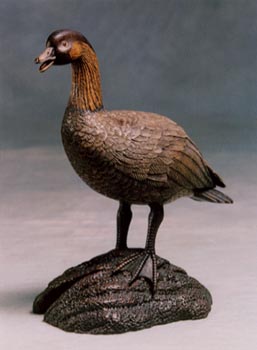 |
Forests a Resource for Fine Wood
Agriculture Hawaii
January-March 2001
by Andrea Gill
There are hundreds of tropical trees that grow well in Hawaii, and many are deliberately plated in urban and residential areas to provide shade, fruit, beauty and other benefits. These "urban forests" grace our boulevards, and color to our campuses, scent the air and absorb noise, sheltering us from the hubbub of civilization.
Tress have much to offer to our landscape and our souls. And, once they approach the end of their natural, life, they can continue to augment our lives if they are turned into fine furniture, stunning sculpture, or even everyday items such as chopsticks and hair picks.
What's the connection? Woodworkers.
Often, when a homeowner trims or removes a tree, the wood can be salvaged and used by Hawaii's many excellent wood crafters. Some woods of particular value — say, pheasant wood or mahogany — are eagerly sought by woodworkers.
If you're thinking of making wood from your urban tree available, consider that it may need to be cut slightly differently to provide the best wood for bowl turning or furniture making. A woodworker might prefer longer lengths if envisioning a table top, or the crotch of a branch may offer the most interesting "curly" figure for a bowl.
Native and non-native woods like are valuable resources. Hawaiian koa, for instance, is not uncommon as an urban accent. Introduced backyard tress such as mango, tangerine, avocado, primavera, Norfolk pine and tamarind are island favorites, and provide wood of different colors and grains.
Variety Is The Spice
 Some of Hawaii's top woodworkers particularly enjoy utilizing a wide variety of woods. In HFIA's September 2000 WoodShow, for instance, an award-winning nene sculpture by Bob Holden was created from pheasant wood, mango, gray tangerine, gray avocado, jacaranda, kaye, hau, false olive, bestill, bloodwood and milo. In 1999's show, Michael Chock crafted a tenor ukulele from koa, red cedar, rosewood Spanish cedar, ebony, holly and maple.
Marian Yasuda's award-winning cabinet in 1998 was built with Eucalyptus citriodora, pheasantwood, ebony, cocobolo, and dyed poplar. The top furniture award at the 1997 Show went to Tom Calhoun for a desk made of Pride of India, koa, avocado burl, silky oak and tamarind. And in 1997, RW Butts created a standing screen featuring 101 different island woods! Some of Hawaii's top woodworkers particularly enjoy utilizing a wide variety of woods. In HFIA's September 2000 WoodShow, for instance, an award-winning nene sculpture by Bob Holden was created from pheasant wood, mango, gray tangerine, gray avocado, jacaranda, kaye, hau, false olive, bestill, bloodwood and milo. In 1999's show, Michael Chock crafted a tenor ukulele from koa, red cedar, rosewood Spanish cedar, ebony, holly and maple.
Marian Yasuda's award-winning cabinet in 1998 was built with Eucalyptus citriodora, pheasantwood, ebony, cocobolo, and dyed poplar. The top furniture award at the 1997 Show went to Tom Calhoun for a desk made of Pride of India, koa, avocado burl, silky oak and tamarind. And in 1997, RW Butts created a standing screen featuring 101 different island woods!
Plant First, Create Later
Hawaii's urban forests provide an enticing pallet for our wood artists. First, though, the trees must be planted. Many organizations are receiving help from the Kaulunani Urban and Community Forest Program, which is funded by the U.S. Forest Service and managed by the state DLNR Division of Forestry and Wildlife. Kaulunani focuses on improving the viability of tress in Hawaii communities through educational programs, cost-share grants, technical training, Arbor Day promotions and partnership with the public and private sectors.
Since its inception in 1992, Kaulunani has awarded grants totalling over $600,000 to more than 130 groups throughout the state. For instance, volunteers and Waipahu Cultural Garden Park on Oahu used a Kaulunani grant to plant 164 trees. Kaulunani provided technical training and funding for Molokai Occupational Center to replant the 130-year-old Kapuaiwa Coconut Grove. And schools have reduced classroom temperatures by as much as 10 degrees by planting trees appropriately. According to Kaulunani coordinator Teresa Trueman-Madriaga, trees are considered major assets in cities. Among their uses:- providing habitat and food for birds and animals in the urban ecosystem;
- providing jobs for landscape architects, horticulturists, arborists and other professionals;
- cooling the environment by shading asphalt, concrete and other surfaces;
- removing impurities from the air and absorbing carbon dioxide and other "greenhouse gases";
- keeping cities and communities beautiful, thus contributing to the economic well-being of the state.
Kaulunani accepts proposals for tree-planting technical training, and educational projects several times each year. For more information, contact Trueman-Madriaga at 672-3383, fax 672-6323, or write to the Department of Land and Natural Resources, Division of Forestry and Wildlife, 1151 Punchbowl St., #325, Honolulu, HI 96813.
Plant a tree! And, when it's time to trim or remove it, remember that it can continue to contribute its beauty for additional decades if transformed into fine woodwork by one of Hawaii's master craftspeople.
|  |
